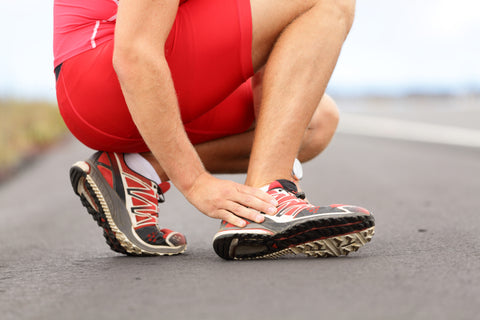Sprains and Strains

Sprains and Strains – Soft tissue injuries and Physicool
The term ‘soft tissue injury’ usually refers to injuries to muscles, ligaments and tendons. These injuries are a common problem in relation to sporting, recreational and physical activities.
A sprain is when ligaments are overstretched or torn. The ankle, knee and wrist are the most common sites for a sprain [1]. A sprained ankle is a common (and painful) injury (See Physicool and ankle sprains section).
A strain occurs when a muscle is overstretched and partially torn. Commonly strained muscles include the hamstrings, gastrocnemius and soleus (calf muscles), quadriceps (front upper leg) and lumbar (lower back)muscles.
Rapid and appropriate treatment is needed to ensure a quick recovery from both sprains and strains. Delayed or inappropriate management can slow down the recovery and healing process.
Physicool cooling and compression bandage is ideal for both first aid and to help the recovery and rehabilitation process.
Grades of sprains and strains
Ankle sprains have been graded according to their severity: [2]:
- Grade I — mild stretching of the ligament complex without joint instability.
- Grade II — partial rupture of the ligament complex without joint instability.
- Grade III — complete rupture of the ligament complex with instability of the joint.
Muscle strains are graded depending on the severity of muscle fibre damage [3]:
First degree strain — this is a mild strain when only a few muscle fibres are stretched or torn. Although the injured muscle is tender and painful, it has normal strength (but power may be limited by pain).
Second degree strain — this is a moderate strain, with a greater number of injured fibres and more severe muscle pain and tenderness. There is also mild swelling, noticeable loss of strength, and sometimes a visible bruise.
Third degree strain — this strain tears the muscle all the way through, sometimes producing a ‘pop’ sensation as the muscle rips into two separate pieces or shears away from its tendon. There is a total loss of muscle function.

Symptoms
Sprains
The severity of symptoms depends on the seriousness of the sprain Common signs and symptoms include [1]:
- Tenderness, swelling and inflammation.
- Bruising.
- Functional loss (for example pain on weight-bearing).
- Pain.
Strains
The symptoms of a muscle strain depend on the severity of the injury and include [1]:
- Pain in the affected muscle.
- Bruising (haematoma) as a result of tearing of the intramuscular blood vessels.
- Swelling.
- Muscle function may be affected, depending on the severity of the strain.
Management
Early and effective management is important to help aid the healing process and lower the risk of recurrent injury. The immediate application of a Physicool cooling bandage to the affected area will help reduce pain and inflammation.
In the early stages, soft tissue injuries are characterized by an acute inflammatory response. PRICE (Protection, rest, ice, compression and elevation) is one of the most recommended approaches for managing soft tissue injuries. The aim is to minimise bruising, swelling, inflammation and pain, to provide the optimum conditions for healing to take place.
The PRICE approach is recommended by NHS Choices [4]:
- Protection – protect the injured area from further injury – using a support bandage if appropriate
- Rest – stop the activity that caused the injury, and rest the injured joint or muscle. Avoid activity for the first 48 to 72 hours after injury.
- Ice – for the first 48 to 72 hours after the injury, apply ice therapy
- Compression – compress or bandage the injured area to limit any swelling and movement that could damage it further.
- Elevation – keep the injured area raised and supported on a pillow to help reduce swelling.
Physicool provides the key elements of PRICE treatment in a single reusable bandage, providing protection, cooling and compression to help the healing process. A Physicool bandage can be applied to the affected area and the cooling effect recharged by spraying Physicool Coolant directly onto the bandage whilst it is in position.
Physicool is a unique cotton bandage impregnated with a patented liquid which draws heat away from the affected tissues by rapid evaporation. While the deep tissues are being cooled, the simultaneous compression effects of Physicool modify the inflammatory response to soft tissue damage which helps promote healing.
A pharmacist or a healthcare professional will be able to recommend the most suitable pain relieving medication.
When to seek medical advice
Seek medical advice if:
- There is significant pain, swelling or loss of function
- You think there may be a fracture
- Your sprain or strain does not improve with home treatments (rest, cooling therapy, over the counter medications).
References
- www.cks.nhs.uk/sprains_and_strains
- Struijs, P. and Kerkhoffs, G. (2007) Ankle sprain. Clinical Evidence. BMJ Publishing Group Ltd.www.clinicalevidence.com
- Jarvinen, T.A., Kaariainen, M., Jarvinen, M. and Kalimo, H. (2000) Muscle strain injuries. Current Opinion in Rheumatology 12(2), 155-161
- www.nhs.uk/Conditions/Sprains
MORE ARTICLES
- Sprains and Strains
- Foot and Ankle Injury
- Knee Injury
- Leg Injury
- Hip and Groin Injury
- Wrist and Hand Injury
- Arm and Elbow Injury
- Shoulder Injury
- Back Injury
- Migraines and Head Injury
- Arthritis
- Delayed Onset Muscle Soreness
- Sports Injuries
- Tennis Elbow
- Elbow Bursitis
Please Note
Some injuries can be self-treated whilst others require prompt medical attention. You should seek advice from a health professional if: the injury causes severe pain, swelling, or numbness; you can't tolerate weight on the area; the pain or dull ache of an old injury is accompanied by increased swelling or joint abnormality or instability.


